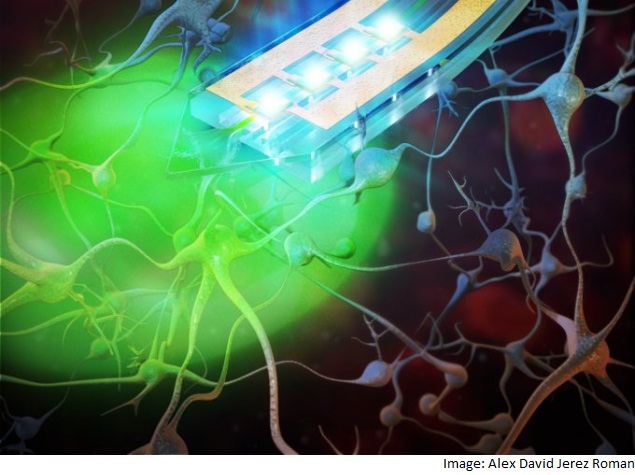- Home
- Science
- Science News
- New Brain Implant Delivers Drugs via Remote Control
New Brain Implant Delivers Drugs via Remote Control

The technology, demonstrated for the first time in mice, one day may be used to treat pain, depression, epilepsy and other neurological disorders in people by targeting therapies to specific brain circuits, according to the researchers at Washington University School of Medicine in St Louis and the University of Illinois at Urbana-Champaign.
"In the future, it should be possible to manufacture therapeutic drugs that could be activated with light," said co-principal investigator Michael R Bruchas, associate professor of anesthesiology and neurobiology at Washington University. "With one of these tiny devices implanted, we could theoretically deliver a drug to a specific brain region and activate that drug with light as needed. This approach potentially could deliver therapies that are much more targeted but have fewer side effects," Bruchas said.
Previous attempts to deliver drugs or other agents, such as enzymes or other compounds, to experimental animals have required the animals to be tethered to pumps and tubes that restricted their movement. But the new devices were built with four chambers to carry drugs directly into the brain. By activating brain cells with drugs and with light, the scientists are getting an unprecedented look at the inner workings of the brain.
The new devices ultimately may help people with neurological disorders and other problems, according to co-first authors Jae-Woong Jeong, a former postdoctoral researcher at the University of Illinois and now assistant professor of electrical, computer and energy engineering at the University of Colorado, Boulder, and Jordan G McCall, a graduate student in the Bruchas lab.
"Now, we literally can deliver drug therapy with the press of a button," McCall said.
"We've designed it to exploit infrared technology, similar to that used in a TV remote. If we want to influence an animal's behaviour with light or with a particular drug, we can simply point the remote at the animal and press a button," he said.
"The device embeds microfluid channels and microscale pumps, but it is soft like brain tissue and can remain in the brain and function for a long time without causing inflammation or neural damage," Jeong added. As part of the study, the researchers showed that by delivering a drug to one side of an animal's brain, they could stimulate neurons involved in movement, which caused the mouse to move in a circle.
In other mice, shining a light directly onto brain cells expressing a light-sensitive protein prompted the release of dopamine, a neurotransmitter that rewarded the mice by making them feel good. The mice then returned to the same location in a maze to seek another reward. The study will be published in the journal Cell.
Catch the latest from the Consumer Electronics Show on Gadgets 360, at our CES 2026 hub.
Related Stories
- Samsung Galaxy Unpacked 2025
- ChatGPT
- Redmi Note 14 Pro+
- iPhone 16
- Apple Vision Pro
- Oneplus 12
- OnePlus Nord CE 3 Lite 5G
- iPhone 13
- Xiaomi 14 Pro
- Oppo Find N3
- Tecno Spark Go (2023)
- Realme V30
- Best Phones Under 25000
- Samsung Galaxy S24 Series
- Cryptocurrency
- iQoo 12
- Samsung Galaxy S24 Ultra
- Giottus
- Samsung Galaxy Z Flip 5
- Apple 'Scary Fast'
- Housefull 5
- GoPro Hero 12 Black Review
- Invincible Season 2
- JioGlass
- HD Ready TV
- Laptop Under 50000
- Smartwatch Under 10000
- Latest Mobile Phones
- Compare Phones
- iQOO Z11 Turbo
- OPPO A6c
- Samsung Galaxy A07 5G
- Vivo Y500i
- OnePlus Turbo 6V
- OnePlus Turbo 6
- Itel Zeno 20 Max
- OPPO Reno 15 Pro Mini 5G
- Lenovo Yoga Slim 7x (2025)
- Lenovo Yoga Slim 7a
- Realme Pad 3
- OPPO Pad Air 5
- Garmin Quatix 8 Pro
- NoiseFit Pro 6R
- Haier H5E Series
- Acerpure Nitro Z Series 100-inch QLED TV
- Asus ROG Ally
- Nintendo Switch Lite
- Haier 1.6 Ton 5 Star Inverter Split AC (HSU19G-MZAID5BN-INV)
- Haier 1.6 Ton 5 Star Inverter Split AC (HSU19G-MZAIM5BN-INV)

















